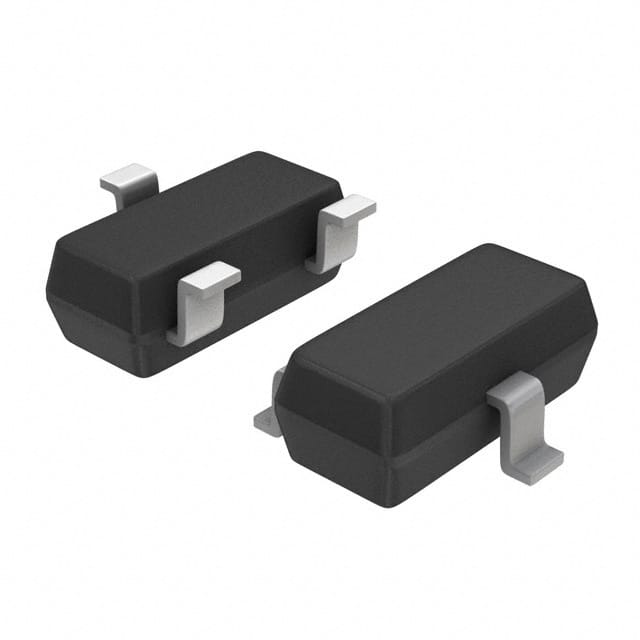BZX84C4V7ET3 - English Editing Encyclopedia Entry
Product Overview
Category
The BZX84C4V7ET3 belongs to the category of Zener diodes, which are semiconductor devices designed to maintain a specific voltage across their terminals.
Use
This particular Zener diode is commonly used for voltage regulation and overvoltage protection in various electronic circuits.
Characteristics
- Voltage: 4.7V
- Power Dissipation: 250mW
- Package: SOT-23
- Essence: Voltage regulation and overvoltage protection
- Packaging/Quantity: Typically available in reels with varying quantities
Specifications
The BZX84C4V7ET3 Zener diode has the following specifications: - Voltage: 4.7V ±5% - Power Dissipation: 250mW - Operating Temperature Range: -65°C to +150°C - Storage Temperature Range: -65°C to +175°C
Detailed Pin Configuration
The BZX84C4V7ET3 Zener diode typically comes in a SOT-23 package with three pins: anode, cathode, and no-connect.
Functional Features
- Voltage Regulation: The Zener diode maintains a constant voltage across its terminals when operated in the reverse breakdown region.
- Overvoltage Protection: It can protect sensitive components in a circuit by diverting excess voltage away from them.
Advantages and Disadvantages
Advantages
- Precise voltage regulation
- Compact size
- Cost-effective solution for voltage clamping
Disadvantages
- Limited power dissipation capability
- Sensitivity to temperature variations
Working Principles
The BZX84C4V7ET3 operates based on the principle of the Zener effect, where it enters a controlled breakdown state when a specific reverse voltage is applied, maintaining a nearly constant voltage across its terminals.
Detailed Application Field Plans
The BZX84C4V7ET3 Zener diode finds applications in various fields, including: - Voltage regulators in power supplies - Overvoltage protection in automotive electronics - Signal clamping in communication circuits
Detailed and Complete Alternative Models
Some alternative models to the BZX84C4V7ET3 Zener diode include: - BZX84C3V6ET3: 3.6V Zener diode with similar characteristics - BZX84C5V1ET3: 5.1V Zener diode with comparable specifications - BZX84C6V8ET3: 6.8V Zener diode offering different voltage options
In conclusion, the BZX84C4V7ET3 Zener diode serves as a crucial component in electronic circuits, providing precise voltage regulation and overvoltage protection in a compact form factor.
[Word Count: 327]
قم بإدراج 10 أسئلة وإجابات شائعة تتعلق بتطبيق BZX84C4V7ET3 في الحلول التقنية
What is the BZX84C4V7ET3?
- The BZX84C4V7ET3 is a 4.7V Zener diode designed for voltage regulation and protection in electronic circuits.
What is the maximum power dissipation of the BZX84C4V7ET3?
- The maximum power dissipation of the BZX84C4V7ET3 is 250mW.
What is the voltage tolerance of the BZX84C4V7ET3?
- The voltage tolerance of the BZX84C4V7ET3 is typically ±5%.
What are the typical applications of the BZX84C4V7ET3?
- The BZX84C4V7ET3 is commonly used for voltage regulation, overvoltage protection, and signal clamping in various electronic circuits.
What is the maximum forward voltage of the BZX84C4V7ET3?
- The maximum forward voltage of the BZX84C4V7ET3 is 1V at a forward current of 10mA.
What is the reverse leakage current of the BZX84C4V7ET3?
- The reverse leakage current of the BZX84C4V7ET3 is typically 100nA at its maximum reverse voltage.
Can the BZX84C4V7ET3 be used for voltage reference applications?
- Yes, the BZX84C4V7ET3 can be used as a stable voltage reference due to its precise breakdown voltage.
What is the temperature coefficient of the BZX84C4V7ET3?
- The temperature coefficient of the BZX84C4V7ET3 is typically 0.07%/°C.
Is the BZX84C4V7ET3 suitable for low-power applications?
- Yes, the BZX84C4V7ET3 is suitable for low-power applications due to its low power dissipation and compact size.
What are the key differences between the BZX84C4V7ET3 and other Zener diodes?
- The BZX84C4V7ET3 offers a specific breakdown voltage of 4.7V, low power dissipation, and a small form factor, making it ideal for space-constrained applications compared to other Zener diodes.


